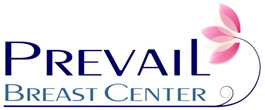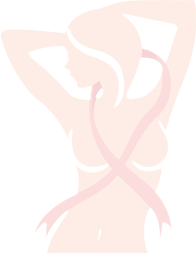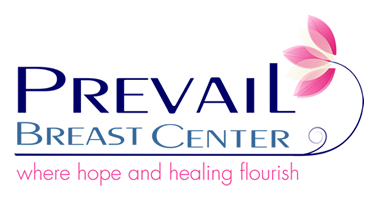Breast Surgery is Comprised of Several Steps….
Please be advised the following descriptions are general in nature as a means to inform you of what you may experience. It is possible your surgical procedure may require different instructions. You are advised to communicate directly with your physician and care providers for instructions specific to your surgery
Before Surgery
Step 1 – Perioperative Instructions
- When you are scheduled for surgery someone from Prevail Breast Center will give you detailed instructions on where to go (which hospital or surgery center) and when to go. Additionally, you will be scheduled to have blood work lab analysis, EKG and possible chest x-ray, performed prior to your day of surgery.
- Before your surgery you will be called by a nurse from the hospital or surgery center who will discuss any medical problems you may have. They will also give you more information about the anesthesia, and further instructions about what medications to take, or not to take, the morning of your surgery.
- As a rule you should not eat or drink after Midnight the night before your surgery, however, you may be advised to take any blood pressure medications the morning of surgery with a tiny sip of water. If you have any questions after speaking with the nurse please call our office.
Day of Surgery
Step 2 – Patient Registration
- Before you come to the hospital remove all jewelry, wear glasses – not contacts – if you need them. Wear loose fitting comfortable clothes and slip-on type footwear as they are easy to remove and put on.
- When you get to the hospital you will go through the patient registration process. This is when you are administratively checked into the hospital. Be sure to bring identification, proof of medical insurance and if necessary, any specific legal directives regarding your care.
Step 3 – Surgery Preparation
- After registration you will be taken back to the pre-operative area where a nurse will ask you to disrobe and put on a surgery gown. Your clothes and personal articles will be put into a bag with your name on it.
- A nurses will start an IV and further check you in for surgery. You will be asked your name, date of birth and what type of surgical procedure will be performed on you. This will happen a few times by different personnel to insure your safety.
- Before the surgery the anesthesiologist and your surgeon will visit you. The surgeon is required to mark the intended surgical site with a marking pen. At this time you will have a chance to ask any last minute questions.
- Family members are usually allowed to wait with you during the time you are in the pre-operative area.
Step 4 – Surgical Procedure is Performed
- Once you are taken to the operating room your family will be directed to the surgical waiting room where a volunteer will keep them informed of the status of the surgery.
- If the surgery is scheduled to last more than 2 hours the nurse in the operating room will come out at regular intervals to inform your family members of the progress of the surgery.
- When you enter the operating room you will be moved onto the operating table. The surgery nurse will continue preparing you for the procedure by making sure all IV’s and monitors are functioning correctly.
- The surgeon will speak with you briefly to make sure you are okay and ready for the procedure. At this time the anesthesiologist will administer the general anesthesia that will put you to sleep for the surgery.
- The surgical procedure is performed.
Step 5 – Post Operation Recovery
- As soon as the surgery is completed the surgeon will come out and speak with your family members to give them an update on your status and how the surgery progressed and the general outcome.
- After surgery you will be moved to the post operative recovery area where you will be closely monitored as you gradually come out from under the anesthesia. Patients typically spend about 1-2 hours in the recovery room.
Step 6 – Post Operation Hospital Discharge
- When you have recovered from the anesthesia and are ready for discharge, a recovery room nurse will meet with family members to go over discharge instructions. This will include what to expect for the next few days and to provide clear instructions for pain medication and wound healing obligations if any. You will also be advised as to when you are free to eat and drink liquids. You will put on your clothes and will be pushed in a wheel chair to the post surgery pick up door.
- Because of the medications used during surgery patients are required to have someone drive them home. Patients must be taken home in a private car and are not released to take a bus or cab.
- It is normal to have some mild or moderate post-operative nausea for up to about 24 hours after surgery but it is NOT normal to have persistent severe nausea especially after the first 24 hours.
- It is highly recommended that a family member of friend remain with you for at least 24 hours to assist and observe you.
Days After Surgery
Step 7 – Pathologic Evaluation
- Regardless of the surgical procedure performed, all tissue that is removed during surgery is sent to the Pathology laboratory for complete evaluation. This is a very important step and usually takes 24-48 hours for the evaluation to be finalized. Occasionally the full evaluation can take up to one week Your breast surgeon will call you with the results as soon as possible.
- Sometimes extra processing time is required. Your surgeon and pathologist may order additional analysis to insure an accurate evaluation of the tissue samples. This extra time does not necessarily mean bad results.
Step 8 – Post Operation Wound Care
- Postoperative wound care- Surgical incisions are closed with sutures that dissolve on their own. This process takes approximately 90 days. Incisions are then covered with a surgical skin glue (Dermabond). This is waterproof and protects the wound while healing. 24 hours after surgery you may take a shower and get the Dermabond wet. Please do not soak the area in a tub however until advised by your surgeon.
- Sports Bra- We highly recommend you have a tightly-fitting sports bra for use after surgery (mastectomy patients excluded). Please bring this to the hospital on the day of your surgery and you will wear it home. Support and gently compression helps decrease post-operative pain, swelling, and bruising. We recommend you wear the sports bra 24 hours a day for at least 5 days. It can be removed for showering and then replaced.
- Pain medications- Patients react variably to prescribed narcotic pain medicines. If you have not taken pain medicine before, we recommend that the medications be taken with food, such as a cracker or some bread. This helps cut down on the nausea some people experience. If you continue to have nausea that prevents you from eating, drinking fluids, sleeping, or getting on with your day stop taking the pain medication to see if the nausea resolves. During this time you can take Tylenol or Advil for any pain. Please call Prevail Breast Center if you have questions or concerns. Narcotic pain medications can also cause constipation. Please be aware of this and modify your diet as necessary. We recommend taking prune juice or a gentle, over-the-counter stool softener like Colace (docusate sodium) or Milk of Magnesia if you are taking narcotic pain medication.
- Jackson Pratt drains- In certain circumstances a small drain/tube (Jackson Pratt or “JP” drain) is placed in the surgical site. These drains collect any fluid that accumulates at the surgery site and routinely stay in for 5 days to 1 week. Patients are taught how to empty them and record their output before leaving the hospital. Recording the output is important as the amount of fluid coming out determines whether the drain can be removed.
Step 9 – One Week Follow Up Office Visit
- After surgery you will have a one week follow up visit with the surgeon.
- The incision site will be inspected by the surgeon to insure it is healing properly.
- If applicable, JP drains are removed. As the insertion site is very small no sutures are required after removal.
- In-depth discussion of pathology report
- Discussion and evaluation of treatment plan and next steps



